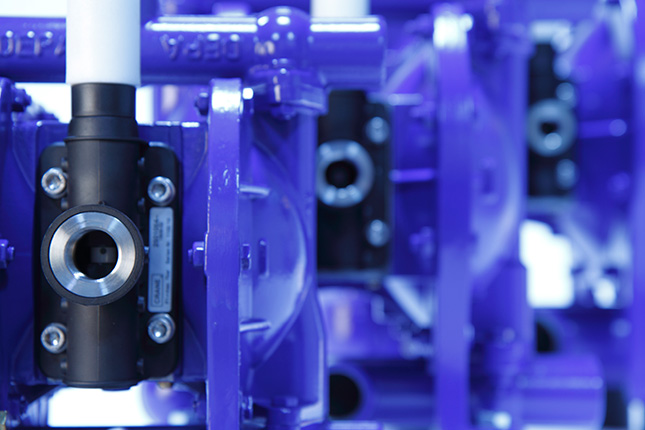Clogged systems, compromised quality and costly repairs are among the serious problems faced by food processing engineers who routinely manage highly viscous solutions with various solid particles. These fluids cause higher operating pressures, increased motor demands, lower flow rates and abrasive handling, presenting a unique set of challenges in food and beverage applications.
 Image 1. AODD pumps offer users benefits including dry self-priming and damage-free dry running capabilities. (Courtesy of Crane ChemPharma & Energy)
Image 1. AODD pumps offer users benefits including dry self-priming and damage-free dry running capabilities. (Courtesy of Crane ChemPharma & Energy)With good suction lift characteristics and the ability to handle sludge and slurries with a relatively high amount of grit and solid content, air-operated double diaphragm (AODD) pumps are an effective solution for these applications.
A positive displacement pump that combines the reciprocating action of a rubber, thermoplastic or Teflon diaphragm with valves on either side, AODD pumps offer users benefits including dry self-priming and damage-free dry running capabilities.
Other advantages include an adjustable variable flow by means of the air supply, low-shear pumping, and a fluid path free of complex seals. These operation and maintenance-friendly pumps are damage-free even when running against a closed discharge valve. AODD pumps are suitable for applications beyond food and beverage, including industrial, chemical and hygienic fluid handling.
AODD pumps offer an effective alternative to more costly pump types and facilitate operations for engineers.
Choosing the right pump is essential for efficient operation in any application, and three primary parameters should guide the selection process—performance, fluid properties and environmental conditions.
When assessing pump performance, users should consider flow rate (displacement), discharge pressure and suction height or pre-pressure. Choosing the right pump size depends on the required flow rate and the backpressure of the system.
Because the specifications for AODD pumps are based on water, it is important to account for fluid viscosity and suction lifts when determining the correct operating point of the pump. The operator defines the operating point based on the application, process and requirements. The operating point helps determine the best size, as well as potential maintenance and energy costs. All aspects—including investment, maintenance and energy costs\'97must be considered when deciding on the pump size for an application.
A pump driven at the limit of the performance curve will experience higher mechanical wear of the elastomers and other components. For example, if a pump is used in continuous operation with a high driving pressure of 7 bar, it is recommended to increase to the next size to reduce the driving pressure while maintaining the flow rate, reduce the number of strokes, and increase the lifespan of the diaphragm.
An in-depth assessment of fluid properties is also essential to the pump selection process. Among the criteria for consideration are the fluid name (to check the material safety data sheet), viscosity, density, concentration of chemical substances, inflammability, temperature, solid content, solid size and powders information (bulk weight and corn size). Fluid viscosity is critical in many food and beverage applications where media is often highly viscous and may contain a variety of solids.
The viscosity of a fluid is a measure of its resistance to internal deformation or shear. For example, molasses is a highly viscous fluid, and water is comparatively less so. The viscosity of gases, however, is quite small compared with that of water.
Fluid viscosity has a significant effect on pump operation, because highly viscous applications, such as those often found in food and beverage processing, present a range of unique challenges in getting the medium in and out of the pump.
As fluid viscosity increases, so does the chance of blockage, pressure buildup and damage to the system. The fact that the viscosity of some fluids—like ketchup—can change at different operating temperatures only creates more issues. As a result, it is important to distinguish between kinematic viscosity (ν) and dynamic viscosity (η or μ), the latter of which is generally used in AODD pump selection. Dynamic viscosity can be calculated using the formula:

System pressure increases as a fluid's dynamic viscosity increases. This adversely affects the performance capabilities of a pump. To help mitigate the effects of high-viscosity media, users should select a larger pump size, start operation slowly with control valves, and position the pump as near as possible to the level of the fluid source. Large ports and valves, increased inlet and outlet manifolds, higher temperatures, and straight tubing without sharp angles can also reduce the challenges of handling highly viscous solutions.
Other criteria to consider during pump selection include materials for use in abrasive or chemical applications and environmental factors such as radiation and convection. In hazardous areas, only pumps approved for use with the corresponding electrically conductive housing material and suitable interior may be used. Temperature is also vital in selecting the correct pump, as both fluid temperature and the ambient temperature must be taken into account. It is important to consider that ambient temperatures vary in indoor versus outdoor installations. Seasonal changes and the difference in heated or non-heated rooms can also affect equipment function.
Because of their unique capabilities not available with other pump types, AODD pumps deliver solutions to a range of applications. Highly efficient with viscous liquids and suspensions, these pumps can help eliminate the difficulties associated with handling large particles in sticky solutions.


